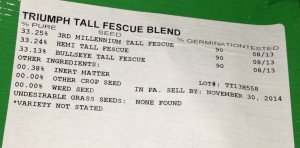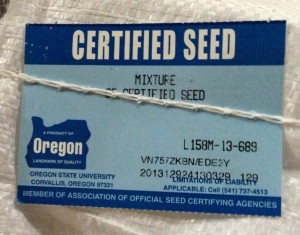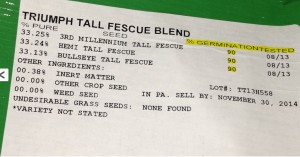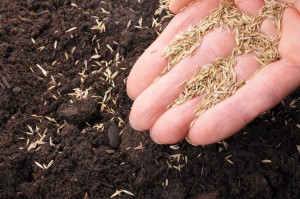What to look for when buying grass seed
Buying the right kind of seed for your lawn shouldn’t be that hard, but it’s a mixed bag. Sun Mix, Shade Mix, Dense Shade Mix, Sun & Shade Mix, Fast Mix, Smart Seed, Coated Seed, Heat-Tolerant Seed…are you ready to walk out of the home improvement store yet? Do you pick your seed by buzz words, pretty bags, or a recognizable brand name? These are all marketing tactics, not good tools to choose the right kind of grass seed for your lawn. To pick what kind of grass seed is right for your lawn, ask yourself these questions.
 What kind of turfgrasses perform best in your area?
What kind of turfgrasses perform best in your area?
Here in Lancaster, PA, there are a few varieties that you can choose from that all have varying applications. Desirable varieties growing in sunny areas typically include Kentucky Bluegrass, Perennial Ryegrass, and Turf-Type Tall Fescue. Good performers in shade are Chewings Fescue, Creeping Red Fescue, and Hard Fescue (typically referred to as Fine Fescues). Seed varieties often have cultivar names, such as the “3rd Millennium” and the “Bullseye” shown on the label here. If you’re seeing varieties that aren’t in the parent classifications listed here, be wary.
Which variety is best for your lawn as it relates to disease, insect, and wear stresses?
There isn’t one “best” seed variety. Depending on the use of your lawn, the history of insect and disease issues, it will change what choice is best. Each variety has its pros and cons.
What is your light exposure in your lawn when leaves are on the trees?
If you are looking at areas that get 6 or more hours of direct sunlight per day, you’ll want to use the sunny varieties listed above. When your lawn gets only 4-5 hours of sunlight per day, you’ll want the shade varieties. If you’re looking at areas that get less than 4-5 hours, good luck! ALL grass varieties need sunlight. You may get shade mixes to germinate, but it won’t be long until they thin out and deteriorate. You’ll need some extra effort with growing grass in the shade to even get minimal success.
What other junk is in that bag of seed?
You’re going to need to look at the seed label and know how to read it. The primary varieties will be listed, but there are other things to look for. Be careful not to buy seed with lots of the following:
- Inert Matter: Inert matter refers to dirt, sand, stones, sticks, stems, broken seed and other miscellaneous non-seed items that have made their way into the seed bag. This is garbage filler, not good seed. The USDA allows up to 15% in a bag. The lower the % of inert matter, the better.
- Other Crop Seed: It’s exactly what you would assume it is. This is seed other than what is in the bag. You don’t want much if any of this either. The lower the % of this the better.
- Weed Seed: It’s hard enough to keep weeds out of a newly seeded area. New grass plants take awhile to mature, and the soil in these areas are often disturbed. This makes dormant weed seeds now viable, too. When you choose a grass seed bag, make sure there is little to no “Weed Seed” in the bag. Otherwise, you’ll be sowing a crop of weeds instead of grass.
- Bad Varieties of Grass Seed: There are too many to list, but stay away from varieties such as Annual Ryegrass, Annual Bluegrass, Rough Bluegrass, K-51 Tall Fescue, Bentgrass, Zoysiagrass, Bermudagrass, etc.
 Is your seed certified by a member of the Association of Official Seed Certifying Agencies?
Is your seed certified by a member of the Association of Official Seed Certifying Agencies?
These laboratories rate seed cultivars. Reputable labs determine the following: is the manufacturer is being true to what is stated to be in their bag? Laboratories also classify how good the seed is. There is extensive research done each year to genetically engineer seed. perform better against drought, disease, and insects. The old cultivars of even 15 years ago just aren’t as good as some of the new ones. This is why frequent aeration and over-seeding is good to do to introduce these new cultivars into your lawn.
 What is the germination % of your grass seed?
What is the germination % of your grass seed?
You should always try to aim for as high of a % as you can, or you’ll need to put more seed down, paying more money. Picking a seed with 85% or higher germination rating is a good idea. You get what you pay for, and this is just another way to determine the quality of your purchase.
After you pick the right seed for your area, be sure to use proper seeding methods to get the best results. We understand the task of selecting the best seed for your lawn can be more than most people want to handle, and may just want to leave the seeding to the lawn care experts. We do our research to find and buy high-quality grass seed, and use proper methods to make it a success. If you would like some professional help with performing your lawn renovation or choosing which seed is right for your lawn, please don’t hesitate to contact us.


